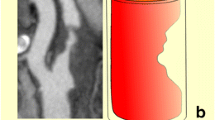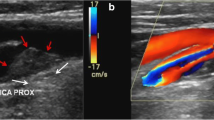Abstract
In the last two decades, a substantial number of articles have been published to provide diagnostic solutions for patients with carotid atherosclerotic disease. These articles have resulted in a shift of opinion regarding the identification of stroke risk in patients with carotid atherosclerotic disease. In the recent past, the degree of carotid artery stenosis was the sole determinant for performing carotid intervention (carotid endarterectomy or carotid stenting) in these patients. We now know that the degree of stenosis is only one marker for future cerebrovascular events. If one wants to determine the risk of these events more accurately, other parameters must be taken into account; among these parameters are plaque composition, presence and state of the fibrous cap (FC), intraplaque haemorrhage, plaque ulceration, and plaque location. In particular, the FC is an important structure for the stability of the plaque, and its rupture is highly associated with a recent history of transient ischaemic attack or stroke. The subject of this review is imaging of the FC.





Similar content being viewed by others
References
Sacco RL, Adams R, Albers G (2006) Guidelines for prevention of stroke in patients with ischemic stroke or transient ischemic attack. Stroke 37:577–617
Rothwell PM, Giles MF, Flossmann E, Lovelock CE, Redgrave JNE, Warlow CP et al (2005) A simple score (ABCD) to identify individuals at high early risk of stroke after transient ischaemic attack. Lancet 366:29–36
Naghavi M, Libby P, Falk E (2003) From vulnerable plaque to vulnerable patient: a call for new definitions and risk assessment strategies. Part I. Circulation 108:1664–1672
Mann JM, Davies MJ (1996) Vulnerable plaque. Relation of characteristics to degree of stenosis in human coronary arteries. Circulation 94:928–931
Murphy RE, Moody AR, Morgan PS, Marten AL, Delay GS, Allder S et al (2003) Prevalence of complicated carotid atheroma as detected by magnetic resonance direct thrombus imaging in patients with suspected carotid artery stenosis and previous acute cerebral ischemia. Circulation 107:3053–3058
Wasserman BA, Wityk RJ, Trout HH, Virmani R (2005) Looking beyond the lumen with MRI. Stroke 36:2504–2513
Ross R (1993) The pathogenesis of atherosclerosis: a prospective for the 1990 s. Nature 362:801–809
Stary H, Chandler A, Dinsmore R et al (1995) A definition of advanced type of atherosclerosis lesions and a histological classification of atherosclerosis. A report from the committee on vascular lesions of the council on Atherosclerosis, American Heart Association. Artherioscler Thromb Vasc Biol 15:1512–1531
Masuda J, Ross R (1990) Atherogenesis during low level hypercholesterolemia in the nonhuman primate. 1. Fatty streak formation. Arteriosclerosis 10:164–177
Masuda J, Ross R (1990) Atherogenesis during low level hypercholesterolemia in the nonuman primate. 2. Fatty streak conversion to fibrous plaque. Arteriosclerosis 10:178–187
Redgrave J, Gallagher P, Lovett J, Rothwell P (2008) Critical cap thickness and rupture in symptomatic carotid plaques: the Oxford plaque study. Stroke 39:1722–1729
Virmani R, Kolodgie FD, Ap Burke, Farb A, Schwartz SM (2000) Lessons from sudden coronary death: a comprehensive morphological classification scheme for atherosclerotic lesions. Arterioscler Thromb Vasc Biol 20:1261–1275
Burke AP, Farb A, Malcom GT, Liang YH, Smialek J, Virmani R (1997) Coronary risk factors and plaque morphology in men with coronary disease who died suddenly. N Engl J Med 336:1276–1282
Falk E (1991) Coronary thrombosis: pathogenesis and clinical manifestations. Am J Cardiol 68:28B–35B
Yuan C, Zhang SX, Polissar NL, Echelard D, Ortiz G, Davis JW et al (2002) Identification of fibrous cap rupture with magnetic resonance imaging is highly associated with recent transient ischemic attack or stroke. Circulation 105:181–185
Saam T, Cai J, Ma L, Cai Y, Ferguson M, Polissar N et al (2006) Comparison of symptomatic and asymptomatic atherosclerotic carotid plaque features with in vivo MR imaging. Radiology 240:464–472
Golledge J, Greenhalgh R, Davies A (2000) The symptomatic carotid plaque. Stroke 31:774–781
Li Z, Howarth S, Tang T, Gillard J (2006) How critical is fibrous cap thickness to carotid plaque stability? A flow-plaque interaction model. Stroke 37:1195–1199
Redgrave J, Lovett J, Gallagher P, Rothwell P (2006) Histological assessment of 526 symptomatic carotid plaques in relation to the nature and timing of ischemic symptoms: the Oxford plaque study. Circulation 113:2320–2328
Bassiouny HS, Davies H, Masawa N, Gewertz BL, Glagov S, Zarins CK (1989) Critical carotid stenosis: morphologic and chemical similarity between symptomatic and asymptomatic plaques. J Vasc Surg 9:202–212
Bassiouny HS, Yashuhiro S, Mikucki SA, McKinsy JF, Piano G, Geewrtz BL et al (1997) Juxtalumenal location of plaque necrosis and neoformation in symptomatic carotid stenosis. J Vasc Surg 26:585–594
Virmani R, Ladich ER, Burke AP, Kolodgie FD (2006) Histopathology of carotid atherosclerotic disease. Neurosurgery 59(Suppl):S219–S227
Wasserman BA, Wityk RJ, Trout HH III, Virmani R (2006) Response to letter by Karapanayiotides et al. Stroke 8:37:1647
Sztajzel R, Momjian S, Momjian-Mayor I, Murith N, Djebaili K, Boissard M et al (2005) Stratified gray scale median analysis and color mapping of the carotid plaque: correlation with endarterectomy specimen histology of 28 patients. Stroke 36:741–745
Hatsukami TS, Ross R, Polissar NL, Yuan C (2000) Visualization of fibrous cap thickness and rupture in human atherosclerotic carotid plaque in vivo with high-resolution magnetic resonance imaging. Circulation 102:959–964
Puppini G, Furlan F, Cirota N, Veraldi G, Piubello Q, Montemezzi S et al (2006) Characterisation of carotid atherosclerotic plaque: comparison between magnetic resonance imaging and histology. Radiol Med 111:921–930
Cai JM, Hatsukami TS, Ferguson MS, Small R, Polissar NL, Yuan C (2002) Classification of human carotid atherosclerotic lesions with in vivo multicontrast magnetic resonance imaging. Circulation 106:1368–1373
Trivedi RA, U-King-Im JM, Graves MJ, Horsley J, Goddard M, Kirkpatrick PJ et al (2004) MRI-derived measurements of fibrous cap and lipid core thickness: the potential for identifying vulnerable carotid plaques in vivo. Neuroradiology 46:738–743
Cai J, Hatsukami T, Ferguson M, Kerwin WS, Saam T, Baocheng C et al (2005) In vivo quantitative measurement of intact fibrous cap and lipid rich necrotic core size in the atherosclerotic carotid plaque: comparison of high resolution, contrast enhanced magnetic resonance imaging and histology. Circulation 112:3437–3444
Coombs BD, Rapp JH, Ursell PC, Reilly LM, Saloner D (2001) Structure of the plaque at carotid bifurcation: high-resolution MRI with histological correlation. Stroke 32:2516–2521
Yuan C, Kerwin WS, Ferguson MS, Polissar N, Zhang S, Cai J et al (2002) Contrast enhanced high resolution MRI for atherosclerotic carotid artery tissue characterization. J Magn Reson Imaging 15:62–67
Wasserman BA, Smith WI, Trout HH III, Cannon RO III, Balaban RS, Arai AE (2002) Carotid artery atherosclerosis: in vivo morphologic characterization with gadolinium-enhanced double-oblique MR imaging―Initial results. Radiology 223:566–573
Stary HC (2000) Natural history and histological classification of atherosclerotic lesions. Arterioscler Thromb Vasc Biol 20:1777–1778
Underlhill HR, Yarnykh VL, Hatsukami TS, Wang J, Balu N, Hayes CE (2008) Carotid plaque morphology and composition: initial comparison between 1.5 and 3.0 T magnetic field strengths. Radiology 248:550–560
Kerwin WS, Liu F, Yarnikh V, Underhill H, Oikawa M, Yu W et al (2008) Signal features of the atherosclerotic plaque at 3.0 Tesla versus 1.5 Tesla: impact on automatic classification. J Magn Reson Imaging 28:987–995
DeMarco JK, Huston J III, Nash AK (2006) Extracranial carotid MR imaging at 3T. Magn Reson Imaging Clin N Am 14:109–121
Takaya N, Yuan C, Chu B, Saam T, Underhill H, Cai J et al (2006) Association between carotid plaque characteristics and subsequent ischemic cerebrovascular events. Stroke 37:818–823
Leighton W, Ismail A, McMeekin W, Lambert D, Mendelow D, Birchall D (2002) Computed tomography angiography for the evaluation of carotid atherosclerotic plaque: correlation with histopathology of endarterectomy specimens. Stroke 33:977–981
Oliver TB, Lammie GA, Wright AR, Wardlaw J, Patel SG, Peek R et al (1999) Atherosclerotic plaque at the carotid bifurcation: CT angiographic appearance with histopathologic correlation. Am J Neuroradiol 20:897–901
De Weert T, De Monyé C, Meijering E, Booij R, Niessen W, Dippel D et al (2008) Assessment of atherosclerotic carotid plaque volume with multidetector computed tomography angiography. Int J Cardiovasc Imaging 24:751–759
Saba L, Mallarini G (2009) Fissured fibrous cap of vulnerable carotid plaques and symptomaticity: are they correlated? Preliminary results by using multi-detector-row CT angiography. Cerebrovasc Dis 27:322–327
Wintermark M, Arora S, Tong E, Vittinghoff E, Lau BC, Chien JD et al (2008) Carotid plaque computed tomography imaging in stroke and non-stroke patients. Ann Neurol 64:149–157
Wintermark M, Jawadif SS, Rappe JH, Tihan T, Tonga E, Glidden DV et al (2008) High-resolution CT images of carotid artery atherosclerotic plaque. Am J Neuroradiol 29:875–882
Arora S, Chien JD, Cheng SC, Chun KA, Wintermark M (2009) Optimal carotid artery coverage for carotid plaque CT-imaging in predicting ischemic stroke. J Neuroradiol [Epub ahead of print]
Stajtzel R (2005) Ultrasonic assessment of the morphological characteristics of the carotid plaque. Swiss Med Wkly 135:634–635
Waki H, Masuyama T, Mori H, Maesa T, Kitade K, Moriyasu K et al (2003) Ultrasonic tissue characterization of the atherosclerotic carotid artery. Circulation 67:1013–1016
Devuyst G, Ruchat P, Karapanayoitides T, Jonasson L, Cuisinaire O, Lobrinus JA et al (2005) Ultrasound measurement of the fibrous cap in symptomatic and asymptomatic plaque atheromatous carotid plaques. Circulation 111:2776–2782
Shi Y, Witte RS, O’ Donnel M (2005) Identification of vulnerable atherosclerotic plaque using IVUS-based thermal strain imaging. IEEE Trans Ultrason Ferroelectr Freq Control 52:844–850
Casscells W, Hathorn B, David M, Krabach T, Vaughn WK, McAllister HA et al (1996) Thermal detection of cellular infiltrates in living atherosclerotic plaques: possible implications for plaque rupture and thrombosis. Lancet 347:1422–1423
MacNeill BD, Lowe HC, Takano M, Fuster V, Jang IK (2003) Intravascular modalities for detection of vulnerable plaque: current status. Artherioscler Thromb Vasc Biol 23:1333–1342
Vengrenyuk Y, Cardoso L, Weinbaum S (2008) Micro-CT based analysis of a new paradigm for vulnerable plaque rupture: cellular microcalcifications in fibrous cap. Mol Cell Biomech 51:37–47
Carr S, Farb A, Pearce WH, Virmini R, Yao J (1996) Atherosclerotic plaque rupture in symptomatic carotid artery stenosis. J Vasc Surg 23:755–766
Acknowledgments
The authors are grateful to Aldo Saitz, Ermanno Saitz, Clemente Atzeni, Paolo Contu, Franco Conti, and Diana Caravana for their valuable help regarding MDCTA and MRI. Moreover, we are deeply indebted to Tiziana Langella, Roberto Sanfilippo, Roberto Montisci, and Letizia Lai.
Author information
Authors and Affiliations
Corresponding author
Rights and permissions
About this article
Cite this article
Saba, L., Potters, F., van der Lugt, A. et al. Imaging of the Fibrous Cap in Atherosclerotic Carotid Plaque. Cardiovasc Intervent Radiol 33, 681–689 (2010). https://doi.org/10.1007/s00270-010-9828-8
Received:
Accepted:
Published:
Issue Date:
DOI: https://doi.org/10.1007/s00270-010-9828-8




